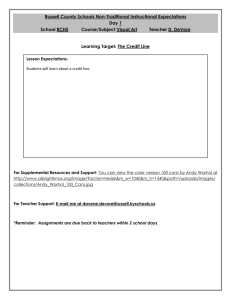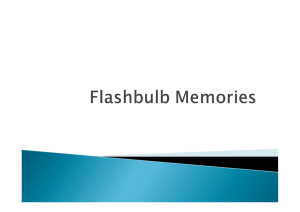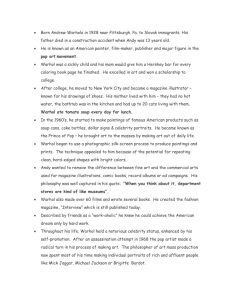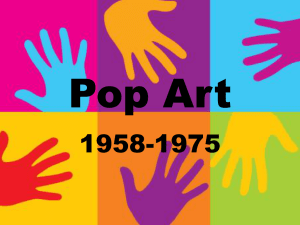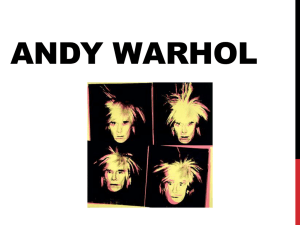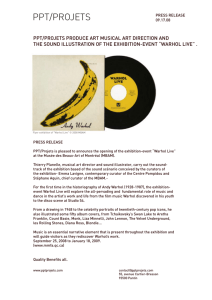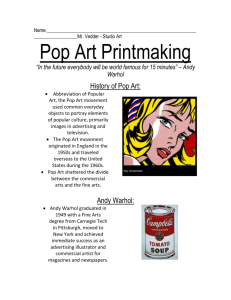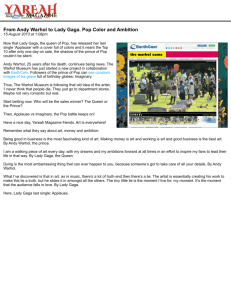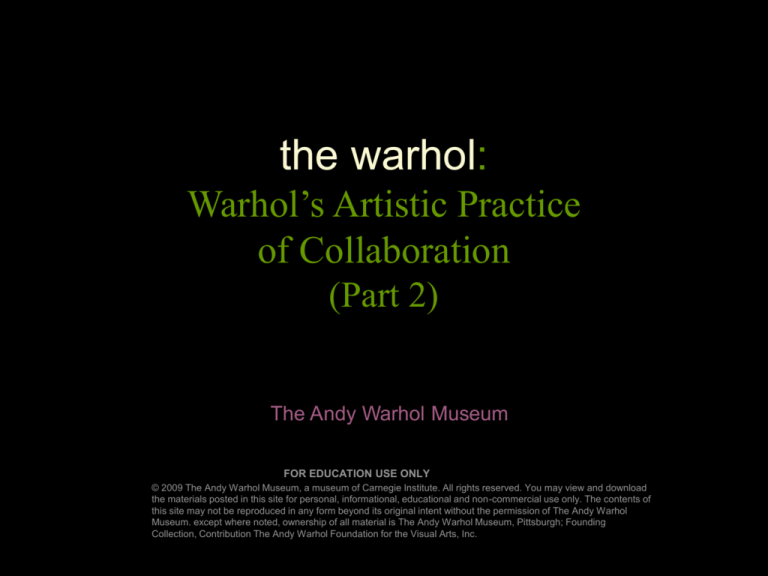
the warhol:
Warhol’s Artistic Practice
of Collaboration
(Part 2)
The Andy Warhol Museum
FOR EDUCATION USE ONLY
© 2009 The Andy Warhol Museum, a museum of Carnegie Institute. All rights reserved. You may view and download
the materials posted in this site for personal, informational, educational and non-commercial use only. The contents of
this site may not be reproduced in any form beyond its original intent without the permission of The Andy Warhol
Museum. except where noted, ownership of all material is The Andy Warhol Museum, Pittsburgh; Founding
Collection, Contribution The Andy Warhol Foundation for the Visual Arts, Inc.
Andy Warhol’s
Artistic Practice of Collaboration
Andy Warhol depended on
a diverse group of people
to help inspire and create
his artwork:
artists, writers, students,
celebrities, musicians,
engineers, and fashion
designers.
Andy Warhol (American, 1928-1987)
Andy Warhol with Leo Castelli, Robert Rauschenberg, Ed Ruscha, James
Rosenquist, Jasper Johns, Claes Oldenburg and others at the Leo Castelli Gallery 25th Anniversary luncheon, The Odeon, New York, February 1, 1982
gelatin silver print 8 x 9 15/16 in. (20.3 x 25.2 cm.)
The Andy Warhol Museum, Pittsburgh
Contribution The Andy Warhol Foundation for the Visual Arts, Inc.© AWF
Warhol’s Studio: The Silver Factory
His studio space doubled
as his “play” space. Called
the “Factory,” it was like a
hive or ant colony always
buzzing with activity.
Andy Warhol (American, 1928-1987)
Fred Schneider, Bernard Zette, John Sex, Benjamin Liu, Way Bandy, Johnny Dynell,
Dianne Brill , Kevin Boyce and Lester Persky, ca. 1986
gelatin silver print 8 x 10 in. (20.3 x 25.4 cm.)
The Andy Warhol Museum, Pittsburgh
Contribution The Andy Warhol Foundation for the Visual Arts, Inc. ©AWF
I don’t really feel all these people with me every day at the Factory are just
hanging around me, I’m more hanging around them… --Andy Warhol
Andy Warhol & The Rock Band
The Velvet Underground
Popular music became
more collaborative and
experimental in the 1960s.
At this time, Warhol
managed one of the most
significant bands of the
decade: The Velvet
Underground. They often
rehearsed in The Silver
Factory.
"The Velvet Underground and Nico" MGM/Verve Records promotional material, 1967
lithograph with ink and felt-tip inscriptions on coated paper, mounted on cardboard stand
20 1/4 x 16 in. (51.4 x 40.6 cm.)
The Andy Warhol Museum, Pittsburgh
Founding Collection, Contribution The Andy Warhol Foundation for the Visual Arts, Inc.
Andy Warhol
The Chelsea Girls, 1966
16mm film, black and white, color, sound, silent, 204 minutes in double screen
Pictured: Nico
©2009 The Andy Warhol Museum, Pittsburgh, PA, a museum of Carnegie Institute. All
rights reserved.
The band joined Warhol’s
multimedia road show:
The Exploding Plastic
Inevitable. Live music,
Warhol’s film projections,
and elaborate light shows
made these performances
collaborative events.
In addition to producing
The Velvet Underground,
Warhol also created their
first album’s well-known
banana cover.
Andy Warhol (American, 1928-1987)
Banana stickers, three unused examples; part of Warhol's design for the 1967 'The Velvet Underground and Nico'
album cover, ca. 1967
printed ink on coated paper
13 1/8 x 12 3/4 in. (33.3 x 32.4 cm.)
The Andy Warhol Museum, Pittsburgh
Gift of David Herrera
©AWF
Andy Warhol & Engineer
Billy Kluver
Andy Warhol, Silver Clouds Installation, at The Andy Warhol Museum, 2000
Artists and engineers are separate individuals, and if they work together,
something will come out of it that neither can expect. --Billy Kluver
• Billy Kluver fostered
collaboration between
engineers and artists because it
provided opportunities for
them to respond to unique and
unplanned challenges.
• As a Bell Laboratories
engineer Kluver’s knowledge
of technology helped bring one
of Warhol’s artistic visions to
life.
Andy Warhol (American, 1928-1987)
Billy Kluver and Unidentified Man, n.d.
gelatin silver print
8 x 10 in. (20.3 x 25.4 cm.)
The Andy Warhol Museum, Pittsburgh
Contribution The Andy Warhol Foundation for the Visual Arts, Inc.
©AWF
Andy Warhol originally
asked for floating light
bulbs; but Kluver gave
him the floating Silver
Clouds instead. Filled
with helium and oxygen
the clouds floated through
the gallery bumping into
each other as well as the
viewer.
Andy Warhol, Silver Clouds Installation, at The Andy Warhol Museum, 2000
Andy Warhol & Graffiti Artist
Jean-Michel Basquiat
• In the 1980s Andy Warhol
collaborated with a young
Haitian/Puerto Rican artist named
Jean-Michel Basquiat.
• Warhol and Basquiat admired
each other’s work and became
close friends, eventually painting
on the same canvases together.
Andy Warhol, Andy Warhol and Jean-Michel Basquiat, 1985
gelatin silver print
8 x 10 in.
The Andy Warhol Museum, Pittsburgh; Founding Collection
Contribution The Andy Warhol Foundation for the Visual Arts, Inc.
Basquiat: Graffiti Artist
• Basquiat was a graffiti
artist who mixed words,
symbols, and images from
pop culture.
• He also combined
mediums such as drawing,
painting, and collage.
Jean Michel Basquiat/Andy Warhol,
Collaboration (Dollar Sign, Don’t Tread on me), 1984-85
Acrylic, silkscreen ink, and oil stick on linen
20 x 16in.
The Andy Warhol Museum, Pittsburgh; Founding Collection
Contribution The Andy Warhol Foundation for the Visual Arts, Inc.
Warhol: Pop Artist
• Warhol used an opaque
projector to trace corporate
logos, newspaper text, and
advertisements onto canvas.
• Basquiat would then paint
onto these canvases using his
freehand style of graffiti in
between Warhol’s areas.
Jean-Michel Basquiat/Andy Warhol, Collaboration, 1984-85
Acrylic and oil stick on linen
76 x 104 1/8in.
The Andy Warhol Museum, Pittsburgh; Founding Collection
Contribution The Andy Warhol Foundation for the Visual Arts, Inc.
• Both artists’ styles are
evident; Basquiat’s is gestural
and expressive, while
Warhol’s is more organized
and slick.
Jean-Michel Basquiat/Andy Warhol, Ten Punching Bags, 1985-86
Synthetic polymer paint on punching bags.
44 x 14 in. each.
The Andy Warhol Museum, Pittsburgh Founding Collection
Contribution The Andy Warhol Foundation for the Visual Arts, Inc.
© The Andy Warhol Foundation for the Visual Arts, Inc.
All Rights Reserved
In addition to paintings, Warhol and Basquiat created a collaborative
sculpture called Ten Punching Bags. Warhol appropriated Leonardo da
Vinci’s Christ from the Last Supper painting and repeated it on each of the
punching bags. Basquiat responded by incorporating the text “judge” and
other symbols onto the bags.
Andy Warhol’s Collaborative Writings
with Pat Hackett
• Whether tape-recording or
photographing, Andy
Warhol documented his
everyday life.
• He called his assistant Pat
Hackett each morning to
report what he had done
the night before.
Andy Warhol on the phone at the Factory, 1966
(photographer unknown)
gelatin silver print
10 x 6 in.
The Andy Warhol Museum, Pittsburgh
Founding Collection, Contribution The Andy Warhol Foundation for the Visual Arts, Inc.
Andy Warhol’s Collaborative Writings
with Pat Hackett
• Hackett was one of
Warhol’s closest
confidantes for many
years.
• She transcribed and
condensed over 20,000
pages of “journal entries”
into The Andy Warhol
Diaries, an 807 page book.
Copyright © 1989 by estate of Andy Warhol
All rights reserved
The Andy Warhol Diaries edited by Pat Hackett
Cover design by Jackie Merri Meyer
Class Discussion
Why was it important for Andy Warhol to collaborate
with a variety of people?
How was Warhol’s studio both his
“work space” and “play space”?

